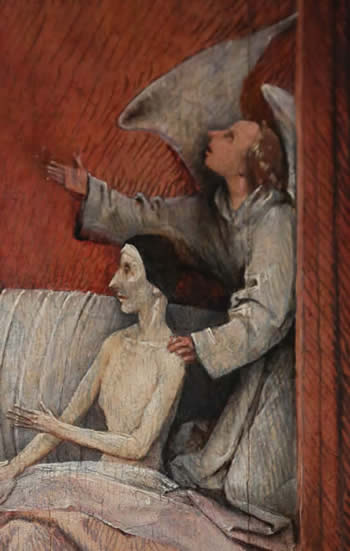|
Death and the miser an esoteric analysis of the painting by Hieronymus Bosch
Preamble
Copyright 2013 by Lee van Laer
|
Following the death of my sister a bit less than 2 years ago, I've been engaged in an ongoing contemplation about the nature of death, and examining Death and the Miser- which ought, more properly, to be called Death and the Patron- in greater detail turned out to be a significant part of that work. I saw the painting in person or the first time at the National Gallery in Washington D.C. in February 2012 and it has been on my mind ever since; it is only on this most recent trip to China that I've had enough time alone to truly ponder the painting and write on it... thinking of this kind is, I find, best done in the early hours of the morning, and in foreign lands.
Any serious analysis of Hieronymus Bosch's symbolism reveals a consistency that may be surprising to the uninitiated. From painting to painting, Bosch employed a portable visual vocabulary that constituted a sophisticated and consistent pictorial language. This was not the highly personalized, nearly onanistic language of today's art; his language was drawn from thousands of years of esoteric understanding, deftly translated into colors, images, and juxtapositions that illustrate classic inner truths known since ancient times. Passed down through schools, many of these Truths reached the Middle Ages through the agency of monasteries and cults of the Virgin largely intact.
Bosch was not just a student, but a master, of such a school, and like many great masters he intentionally left behind a spiritual legacy that eclipses what little personal information we have about him.
The more I study his paintings, the more surprised I am by the popular and ingrained impression that his work is obscure, or difficult to understand. I think any student of the inner arts is able, with a little effort, to see exactly what he was speaking of; and the likelihood that his paintings were (as I think) works with legitimate and tangible popular appeal engenders the idea that the society he lived in was far more interested in inner questions than the one we live in today. It may be, in fact, that it's our own relative social and cultural poverty in these matters that causes his paintings to look obscure to us.
His art, in other words, may be as much as a record of what we have lost, as of what he discovered. Death was a more tangible impression in the Middle Ages and the Renaissance; it came, on average, much earlier, and often with far less warning. This uncomfortable proximity, and its consequent urgency, caused people to contemplate the nature of life more concisely than we do today; and we can learn from them—especially from Bosch, who, it's clear, understood more than the average person.
Considered in depth and at length, the work leaves an indelible inner impression. Despite the apparent simplicity of the work, it plants a seed that grows as one contemplates it; and it is a testament to the durability of both the imagery and its symbolism that the painting continues to yield insights long after the first impressions are taken. The work is a work to be not so much viewed, as taken in and digested.
It speaks not to the outer, but the inner man; and this is in the nature both of koans— questions which pose conundrums that cannot be answered with the ordinary mind— and esoteric works which attempt to convey information to our inner Being, that sacred realm yet uncorrupted by our ordinary concerns and desires.
Unlike Ozymandias, Bosch invites us to look upon his works and hope; and in an age when consumerism, materialism and our ever-shallowing cults of personality seem poised to relentlessly tilt mankind towards despair, it's an invitation well worth accepting.
There are times, looking at his paintings, when I'm tempted by the conceit that he painted his works for our own age, not his; then again, that is the true test of works whose nature is timeless.
Death and the Miser- return to the commentary
